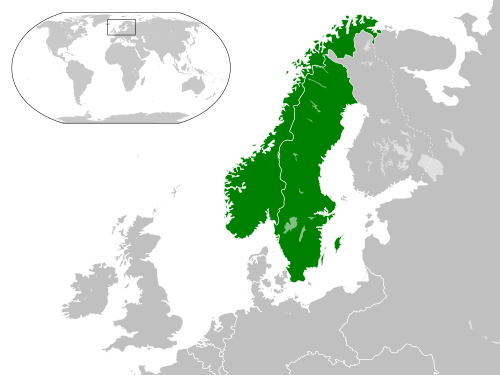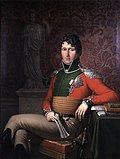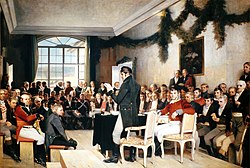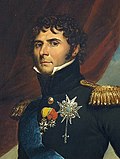Union between Sweden and Norway
The Union of Sweden and Norway (Swedish: [Svensk-norska unionen] Error: {{Lang}}: text has italic markup (help); Norwegian: [Den svensk-norske union] Error: {{Lang}}: text has italic markup (help)), officially the United Kingdoms of Sweden and Norway, was a personal union. It consisted of the separate kingdoms of Sweden and Norway under the same monarch. It lasted from 1814 to 1905.[3] In 1905 Sweden accepted Norway leaving the union.[4] Both states kept their separate constitutions, laws, legislatures, administrations, state churches, armed forces, and currencies. However the kings mostly resided in Stockholm. Stockholm was also the town where foreign diplomatic representations were located.
United Kingdoms of Sweden and Norway Förenade konungarikena Sverige och Norge De forenede Kongeriger Norge og Sverige | |||||||||||||
|---|---|---|---|---|---|---|---|---|---|---|---|---|---|
| 1814–1905 | |||||||||||||
 Sweden and Norway in 1905 | |||||||||||||
| Status | Personal union | ||||||||||||
| Capital | Stockholm & Christiania[a] | ||||||||||||
| Common languages | Swedish, Danish, Norwegian[b], Western Sami languages | ||||||||||||
| Religion | Protestant (Lutheran) Christianity | ||||||||||||
| Government | Constitutional monarchies | ||||||||||||
| King | |||||||||||||
• 1814–1818 | Charles XIII/II | ||||||||||||
• 1818–1844 | Charles XIV/III John | ||||||||||||
• 1844–1859 | Oscar I | ||||||||||||
• 1859–1872 | Charles XV/IV | ||||||||||||
• 1872–1905 | Oscar II | ||||||||||||
| Legislature | Legislatures:[d] | ||||||||||||
• Swedish legislature | Swedish Parliament | ||||||||||||
• Norwegian legislature | Parliament of Norway | ||||||||||||
| Historical era | 19th century | ||||||||||||
| 14 January 1814 | |||||||||||||
• | 4 November 1814 | ||||||||||||
• Constitution of Norway amended | 4 November 1814 | ||||||||||||
| 16 October 1875 | |||||||||||||
• Norway declares independence | 7 June 1905 | ||||||||||||
| 13 August 1905 | |||||||||||||
• | 26 October 1905 | ||||||||||||
| Area | |||||||||||||
| 1905 | 774,184 km2 (298,914 sq mi) | ||||||||||||
| Population | |||||||||||||
• 1820 | 3550000[c] | ||||||||||||
• 1905 | 7560000[c] | ||||||||||||
| Currency | Sweden: Riksdaler, (1814–1873) Krona (1873–1905) Norway: Speciedaler, (1814–1875) Krone (1875–1905) | ||||||||||||
| |||||||||||||
a. ^ The king resided alternately in Stockholm (mostly) and Christiania (usually some months of each year). He received ministers from both Sweden and Norway in Union council, or separately in only Swedish or Norwegian councils. The majority of the Norwegian cabinet ministers convened in Christiania when the king was absent. b. ^ The written Norwegian language ceased to exist in the first half of the 16th century and was replaced by Danish. Written Danish was still used during the union with Sweden, but was slightly norwegianized in the latter half of the 19th century. In 1885, the Parliament of Norway accepted Landsmål as an official written language at par with Danish. c. ^ 1820: 2,585,000 in Sweden, and 970,000 in Norway.[1] 1905: 5,260,000 in Sweden, and 2,300,000 in Norway.[2] d. ^ The Swedish Parliament was a diet composed of four estates until 1866. That year it became into a bicameral legislature. The Parliament of Norway was a unicameral legislature. In the Norwegian parliament the cabinet needed support from the majority. | |||||||||||||
Union Between Sweden And Norway Media
Jean Baptiste Bernadotte, Marshal of France, Crown Prince of Sweden in 1810 and Norway in 1814, and King of Sweden and Norway in 1818. Portrait by Joseph Nicolas Jouy, after François-Joseph Kinson
King Charles XIII (Charles II in Norway)
Christian Frederik, hereditary prince of Denmark and Norway, King of Norway May–October 1814, and King of Denmark (as Christian VIII) 1839–48. Portrait by Johan Ludwig Lund 1813
Oscar Wergeland: The Norwegian Constitutional Assembly in 1814
Christian Magnus Falsen, at 32, was credited as being the constitution's father.
Map of Norway and Sweden in 1847, by Peter Andreas Munch
King Charles XIV John (Charles III John in Norway). Portrait by Fredric Westin
References
- ↑ Tacitus.no - Skandinaviens befolkning (in Swedish)
- ↑ "SSB - 100 års ensomhet? Norge og Sverige 1905–2005 (in Norwegian)". Archived from the original on 2014-11-19. Retrieved 2015-01-17.
- ↑ "Sweden". World Statesmen. Retrieved 17 January 2015.
- ↑ "Norway". World Statesmen. Retrieved 17 January 2015.









